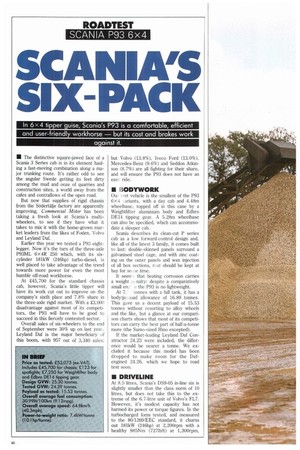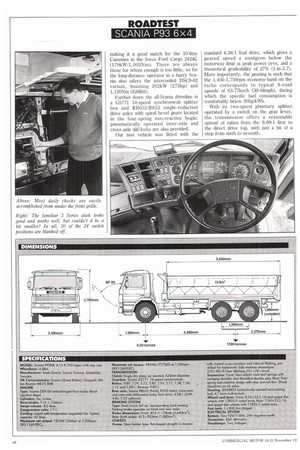SCANIA'S SIX-PACK
Page 48

Page 50

Page 51

Page 52

If you've noticed an error in this article please click here to report it so we can fix it.
In 6 \ 4 tipper guise, Scania's P93 is a comfortable, efficient and user-friendly workhorse — but its cost and brakes work against it.
• The distinctive square-jawed face of a Scania 3 Series cab is in its element hauling a fast-moving combination along a major trunking route. It's rather odd to see the angular Swede getting its feet dirty among the mud and ooze of quarries and construction sites, a world away from the cafes and contraflows of the open road.
But now that supplies of rigid chassis from the Sodertalje factory are apparently improving, Commercial Motor has been taking a fresh look at Scania's multiwheelers, to see if they have what it takes to mix it with the home-grown market leaders from the likes of Foden, Volvo and Leyland Daf.
Earlier this year we tested a P93 eightlegger. Now it's the turn of the three-axle P93ML 6x4R 250 which, with its sixcylinder 181kW (246hp) turbo-diesel, is well placed to take advantage of the trend towards more power for even the most humble off-road workhorse.
At V15,700 for the standard chassis cab, however, Scania's little tipper will have its work cut out to improve on the company's sixth place and 7.8% share in the three-axle rigid market. With a £3,000 disadvantage against most of its competitors, the P93 will have to be good to succeed in this fiercely contested sector.
Overall sales of six-wheelers to the end of September were 30% up on last year. Leyland Daf is the major beneficiary of this boom, with 957 out of 3,340 sales; but Volvo (13.8%), lveco Ford (13.0%), Mercedes-Benz (9.6%) and Seddon Atkinson (8.7%) are all fighting for their share, and will ensure the P93 does not have an easy ride.
• BODYWORK
ou,. I.st vehicle is the smallest of the P93 6x4 .ariants, with a day cab and 4.48m wheelbase, topped off in this case by a Weightlifter aluminium body and Edbro DE14 tipping gear. A 5.28m wheelbase can also be specified, which can accommodate a sleeper cab.
Scania describes its clean-cut P series cab as a low forward-control design and, like all of the latest 3 family, it comes built to last: double-skinned panels surround a galvanised steel cage, and with zinc coating on the outer panels and wax injection of all box sections, rust should be kept at bay for so Ile time.
It seen-that beating corrosion carries a weight 1.,-nalty: despite a comparatively small en., (! the P93 is no lightweight.
At 7.tonnes with a full tank, it has a body/ix: load allowance of 16.89 tonnes. This gave us a decent payload of 15.53 tonnes without resorting to alloy wheels and the like, but a glance at our comparison charts shows that most of its competitors can carry the best part of half-a-tonne more (the Sumo-sized Hino excepted).
If the market-leading Leyland Daf Constructor 24.23 were included, the difference would be nearer a tonne. We excluded it because this model has been dropped to make room for the Dafengined 24.26, which we hope to road test soon.
• DRIVELINE
At 8.5 litres, Scania's DS9-05 in-line six is slightly smaller than the class norm of 10 litres, but does not take this to the extreme of the 6.7-litre unit of Volvo's FL7. However, it's modest capacity has not harmed its power or torque figures. In the turbocharged form tested, and measured to the 80/1269/EEC standard, it churns out 181kW (246hp) at 2,200rpm with a healthy 985Nm (727Ibft) at 1,300rpm, making it a good match for the 10-litre Cummins in the Iveco Ford Cargo 2424C (179kW/1,005Nm). There are always those for whom enough is too little, so for the long-distance operator in a hurry Scania also offers the intercooled DSC9-02 variant, boasting 202kW (275hp) and 1,120Nm (8261bft).
Further down the all-Scania driveline is a GS771 10-speed synchromesh splitter box and RB652/R653 single-reduction drive axles with spiral bevel gears located in the four-spring non-reactive bogie; pneumatically operated inter-axle and cross-axle diff-locks are also provided.
Our test vehicle was fitted with the standard 4.38:1 final drive, which gives a geared speed a smidgeon below the motorway limit at peak power revs, and a theoretical gradeability of 27% (1-in-3.7). More importantly, the gearing is such that the 1,450-1,750rpm economy-band on the tacho corresponds to typical A-road speeds of 63-771un/h (39-48mph), during which the specific fuel consumption is comfortably below 205g/kWh.
With its two-speed planetary splitter operated by a switch on the gear lever, the transmission offers a reasonable spread of ratios from the 9.89:1 first to the direct drive top, with just a bit of a step from sixth to seventh.
I PERFORMANCE
Heading north on the M1 from our Milton Keynes starting point, we soon discovered that the Scania is not handicapped by its A-road gearing when asked to deliver the goods on the motorway.
Some transport engineers might feel that 2,200rpm is asking a bit much of an engine for long periods, but out on the road the in-line six remains smooth and quiet at high revs, with a subdued whistle from the turbo being the dominant noise (we recorded a commendable 74.4dB(A) at 96km/h).
Away from the motorway, the P93 continued its composed display, maintaining good progress on the ups and downs of the A422, with the engine willing to pull from below 1,200rpm. As expected, top gear was ideally suited to this sort of running.
Gradeability should prove adequate for those operating in hilly areas: the P93 scaled the 25% (1-in-4) test slope in first gear with little difficulty.
In all types of driving, the 10-speed synchromesh splitter box is an excellent companion. With the aid of the pleasantly weighted clutch, full gear changes are pick and smooth, backed up by the splitter switch which is a simple and efficient .=!xample of the breed.
On the flat the P93 starts off quite lappily in third, and a typical sequence is 3-5-6-7-9-10. The gear pattern is slightly odd, with half gears selected using the splitter button in the bottom six ratios, but using the lever in the top four (so that the fourth-gear position gives ratios 7 and 9; and fifth gives 8 and 10); this sounds worse than it is, and once familiar is not troublesome.
• ECONOMY
Few tippermen will argue with the P93's overall return of 31.01it/100km (9.1mpg) recorded at a useful average speed of 64.8km/h (40.3mph). These figures stack up well against the sector's big-sellers like the Cargo 2424C (30.91it/100km) and the outgoing Constructor 24.23 (31.51it/ 100km), and they beat the smallerengined FL7 (33.11it/100km).
As anticipated, the hard-working power plant did worse on the motorway section, drinking diesel at a rate of 31.881it/100km. It did slightly better over slower A-road terrain, at 30.41it/100km. Taken as a whole, the performance economy balance must be seen as a good one.
II HANDLING
The P93's multi-leaf steel suspension with its non-reactive rear bogie performs well, and rides comfortably in on and off-road conditions. On country roads the Scania copes confidently with mid-corner bumps, and the rear anti-roll bar keeps body roll under control.
Similarly, the cab is firmly suspended, and the amount of cab movement is not off-putting. With only 4.1 turns from lock to lock, the power steering gives the tipper a responsive feel in tight going, but if anything the assistance is a little too great, robbing the driver of valuable feedback from the road.
In normal driving brake performance is adequate, and can be supplemented with an effective exhaust brake when required. Against this, the brake pedal is not particularly progressive, and we were disappointed by slight juddering we felt when braking hard.
On the test track a more worrying aspect of braking performance became apparent, which had also been noted on our test of the 8 x 4 P93. During emergency stops, the rear bogie locked up well before the front axle, dragging the vehicle off line. From 641un/h, the rearwheels painted a thick strip of rubber on the track fully 25m long.
The ability of the brakes to stop the tipper is not in question the level of deceleration recorded was actually quite good but Scania owes it to drivers to give them directional stability as well as stopping power.
• CAB COMFORT
The Scania 3 Series cab is a very nice place to work. It is tastefully trimmed, thoughtfully equipped and nicely finished (though electric windows on a tipper do seem a bit out of place!).
With a steering wheel that adjusts for reach and rake, and a well-shaped seat, there will be few drivers who cannot make themselves comfortable. Visibility is good (although we remain unconvinced of the merits of the large plastic visor above the windscreen); mirrors are well sited, and there is an effective heating and ventilation system which includes a heated driver's seat.
There is plenty of storage space for documents and smaller odds and ends, but as there is no room behind the seats, larger items are condemned to the footwells. The trim, however, should last well, given the occasional scrub, and the hefty rubber mats can be removed along with their covering of mud.
While the attractive curved dashboard undoubtedly presents the instruments in an efficient manner, we have some reservations about the amount of space it takes up. This is a consequence of the modular design of the minor control panels, which leads to the rocker switches being dotted about all over the place; is it really necessary to ha.. 24 sites for switches, of which 20 remain blanked off?
We agree that the design allows for all kinds of accessories, and a dash with 24 working switches would doubtless be a dream for some owner-operators; but surely a more compact fascia design would serve the needs of a working truck like a tipper rather better, as well as improving the cross-cab access which is optimistically summed up as poor.
• SUMMARY
Putting cost to one side for a moment, the P93ML 6x4R 250 is undoubtedly a very nice little truck. It is a bit overweight, and could be tricky in an emergency stop, but it is pleasant to drive, offers a good balance between performance and economy, and comes from a manufacturer with a reputation for doing things right.
With the standard final drive it is happier away from the motorway, but our experience is that despite this it handles all types of going in a smooth and unruffled fashion.
Dial price into the equation, however, and the case for Scania's small tipper becomes less convincing. With more productive tippers available for £3,000 less, operators will demand convincing arguments for choosing it above the established competition. While this state of affairs remains, we feel the sight of a P93 getting mucky for a living will be rare. LJ by Peter Watt


























































































































